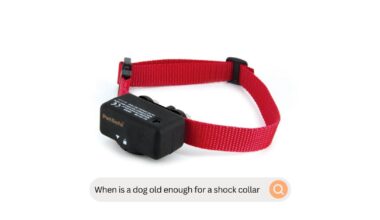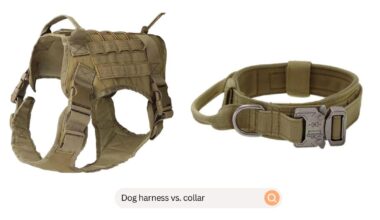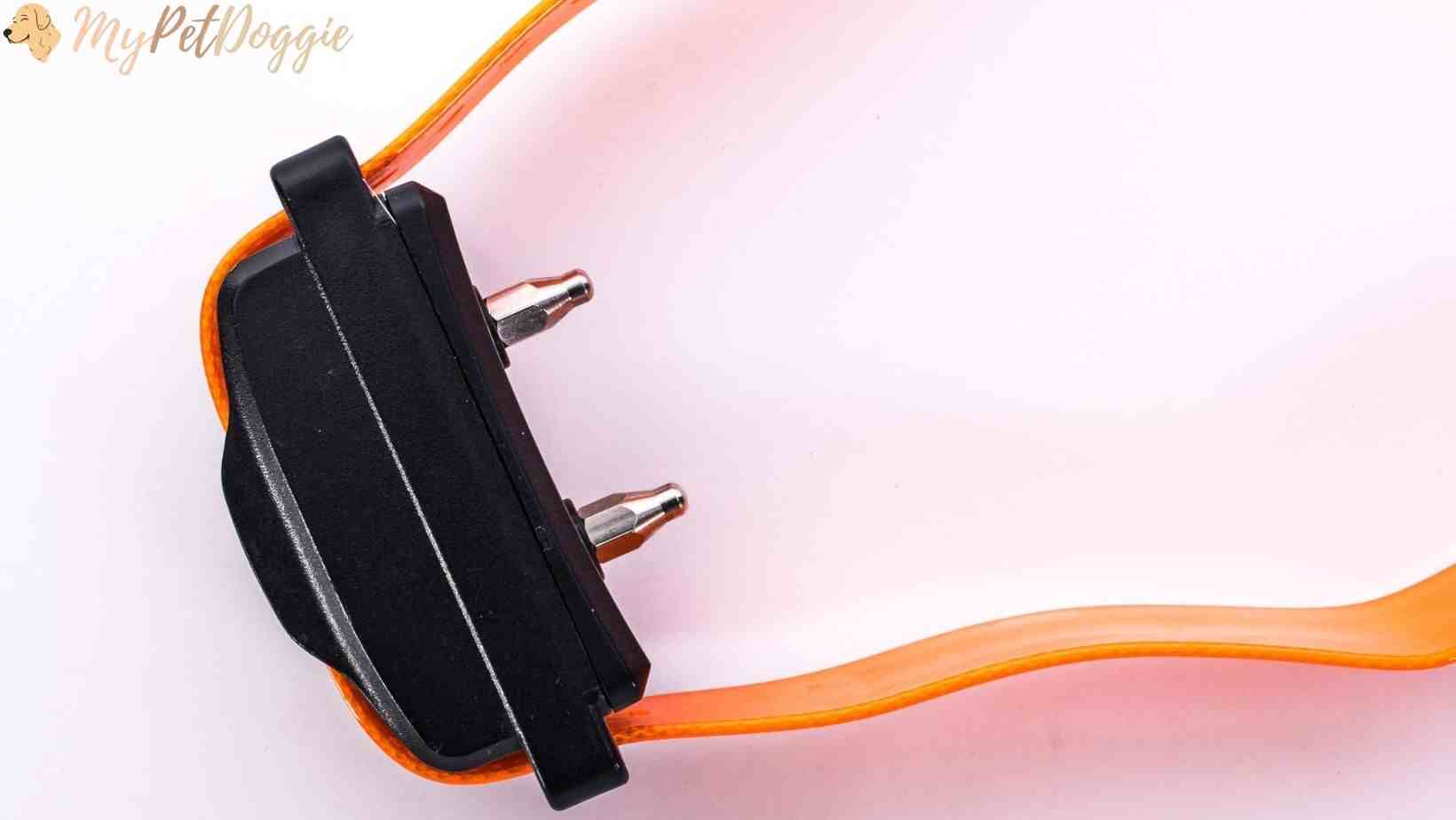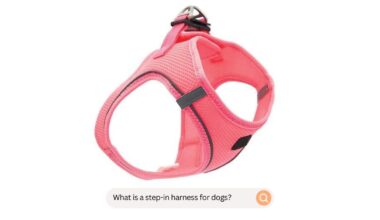About the Author: Nettie Finley, the Professional Dog Trainer at MyPetDoggie. Specializing in behavior rehabilitation, Nettie leads our team with her effective training techniques. As a certified canine behaviorist, she brings transformative change to challenging behavior cases. Her experience and expertise elevate our content, providing practical, insightful training advice for our readers. Also, she loves her Cavapoo!
These are just a few of the questions that come to mind when you hear about the use of shock collars in dog training. Fortunately, there is plenty of information available to help you decide if e-collars are the right solution for your dog training needs. In this article, we will discuss the facts about shock collars.
As you might have guessed, the answer depends on your dog and your situation. There are plenty of reasons why you might want to use a shock collar on your dog. Perhaps you need to train your dog not to jump on visitors, and you need to train your dog not to initiate behaviors that might scare other dogs.
In this article, I will specifically discuss “How Many Volts is a Dog Shock Collar?”.
You can also read: In-Depth Review – Best Shock Collar for Rottweiler
Key Takeaways
What is a dog shock collar?

It is a remote-controlled device that delivers a small electric shock to the dog when he does something wrong. Most people use shock collars to train their dogs to obey commands, such as “sit” or “stay.” Other people use shock collars to train their dogs to not do something, such as to stay away from something they are not supposed to touch.
Related Article: Best Shock Collar for Aggressive Dog
These devices deliver an electric shock to your dog when they act out. These can be helpful if your dog has issues with aggression or separation anxiety. There are some downsides to using a shock collar.
Most importantly, it can cause obedience training to become negative reinforcement. This can backfire, causing your dog to want to perform bad behaviors even more. You can also hurt your dog’s feelings with a shock collar. These devices use an electric shock, so you should always make sure your hands are far enough away.
Other than that use shock training only when you are trained enough, as it is one of the most effective ways of training and it can prove very fruitful.
Related Article: Best Bark Collar for Small Dogs
We recommend you to read up on the benefits of using an e-collar first to understand if it’s right for your pet. You can start slowly applying just enough voltage to get your dog’s attention; this will be enough for most dogs.
If your dog shows any signs of aggression or fears you, then you can increase the voltage slowly until you get to the point where your dog is not responding to commands anymore. You can use the collar for a short period of time, or even use it whenever your dog is showing aggressive behaviors.
With a positive charge, this is supposed to help your dog learn what they need to do to avoid the shock, and it is a common training method, so you can use it for obedience or for something else if you want to.
Your dog may respond very differently to a shock collar than a training one. Of course, this depends on the dog’s size and temperament as well. A shock collar is not necessarily more harmful than a training one, but it could be.
That’s why it’s important to do your research and purchase a collar that is designed for the correct use of electric stimulation. If you do go this route, please make sure to follow the instructions provided.
The training collars are usually attached to a collar that fits around your dog’s neck. Some of these training collars use an electric shock to cue your dog to obey. Some of these training collars may also use vibration or tone to communicate with your dog.
As a dog owner, it can be difficult to know when to trust our dogs and when to intervene. With the remote control, you can feel confident knowing your dog is in the hands of a professional trainer. You can let them have their space, and while they move around freely you always have control on them through a remote.
This can calm your dog down a bit and stop the barking, so you can get some peace and quiet. Some beep-only dog collars have a vibration mode as well.
In addition to the tone, some models have vibration as a second option. Dogs do not like the feeling of electricity in their bodies, so this can be a great way to help stop a dog from barking.
You can also read: Must-Read – Best Shock Collar for Great Dane
How Many Volts is a Dog Shock Collar?

Dog health is important for both you and your dog, and there are things you can do to improve it. This will not only make your dog happier but also healthier. If you’re working on training a dog with anxiety, then you want to start with positive reinforcement. As soon as he does something you like, give him a treat. Soon he will associate doing things you like with getting a reward, not something scary and unpleasant.
Training sessions are a great time to show your dog that walking with you is something enjoyable, not stressful. Give his favorite treat at the end of your walk.
Most electric dog collars don’t exceed 100V, which is the voltage of a typical household outlet. As long as your dog doesn’t have a weak heart, an electric shock is unlikely to cause any serious issues. However, there are some precautions you should take, especially if your dog is prone to aggression.
- If your dog becomes aggressive or unruly, stop using the collar immediately.
- Most electric dog collars don’t come with a way to lower the current. Therefore, if your dog becomes too aggressive and exhibits signs of stress, such as panting or licking its paws, the collar may make the situation worse.
- Never leave your dog unattended when wearing an electric dog collar.
The shock collars can have 0-1000V settings. It depends on the trainer to have the right setting on the shock collar. This is enough to cause a shock but not enough to be fatal. Most shocks in this range will feel like a static shock. The intensity of the shock will depend on the setting of the collar.
For example, a low setting will feel like a mild shock, a medium setting will feel like a moderate shock, and a high setting will feel like a strong shock. The common range of shock varies between 100-300V.
Your dog’s size will also play a role in which kind of shock collar it should be using. For example, small dogs will respond better to a gentle vibration while large dogs will be more responsive to a more powerful shock. The strength of the shock you give your dog will also depend on the severity of the problem it’s trying to correct. You can start with a low setting when training your dog and then gradually increase the intensity of the shock as your dog learns to obey.
You can also read: Product Review – The Best Shock Collar for Golden Retrievers
Do You Know There Are Three Basic Types of Shock Collars?
Below I’ll discuss three different types of shock collars that are used to train dogs:
Stimulus-response shock collar

The best electronic dog collars can be controlled with a remote and sends an electric charge to the collar to give your dog an unpleasant shock. Electronic dog collars are a safe and effective way to train your dog. They cause no physical pain to your pet and are very effective in dog obedience training and dog behavior modification.
You can use electronic dog collars to train your dog to sit, down, stay, come, and many other behaviors. Electronic dog collars can help you deal with certain behaviors that your dog might exhibit (such as barking or chewing) in a controlled and positive way. Electronic dog collars are also a reliable tool for dog obedience training.
If your dog is fairly new to training, then you should probably start off with a positive reinforcement training system so your dog learns from a positive and enjoyable experience. Not all dogs learn best from negative consequences. After that you can use shock collars to enforce the right behavior.
In order for these kinds of training methods to work, you need to be consistent. These types of electronic training collars can be used for obedience training, behavior modification, or simply to keep your dog from behaving aggressively.
Stimulus-intermittent shock collars work in a similar way, emitting a small electric shock every time your dog does something he is not supposed to do. These types of dog training collars are far more popular than the continuous ones, and are usually more affordable.
Those who are beginners should try to avoid it or seek professional help. If these collars are not effectively and properly used they be harmful to you and your dog.
You can also read: Product Review – Best Shock Collar for Labrador Retriever
A remote Activation shock collar
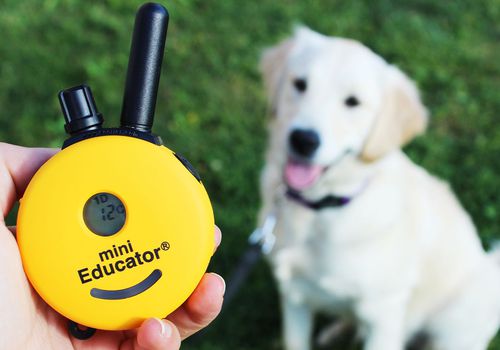
You can use the remote to give your dog a shock or you can use it to train your dog. The remote used in this product is a handheld device which is rechargeable. You can use the remote as many times as you want. Also make sure the collar is waterproof so, it will not limit you to indoor trainings.
With the remote, you become able to switch between different settings of stimulations. By pressing the buttons you can increase or decrease the stimulation level.
This beep only collar will allow you to train your dog when it’s time to come in from the yard, leave a room, or stop barking. This is perfect for training your dog to stop barking on command or to go to a specific spot. It’s safe for use on dogs of all sizes and even for use on puppies.
The only thing you need to be careful of is not using the collar too close to your dog’s neck. You want the collar to be at least a finger’s width away from your dog’s neck. If you’re using the collar to train your dog, it’s important to praise and reward your dog when it does as expected.
Remote-controlled modern shock collars have additional features like vibration and sound. Both vibration and tone are milder stimulation that won’t cause pain but may still be effective for training and teaching your dog not to bark. Some dogs may respond better to tone alone, while for some you may think to switch to vibration or shock mode.
Some models come with an automatic turn-off feature for convenience.
Although you have these great features do you know it can produce upto 1500V? It’s simply aversive stimulation that your dog will learn to associate with unwanted behavior and avoid in the future.
By shocking your dog, you are sending a message that any unwanted behavior will result in something unpleasant. The shock doesn’t have to be painful, it could just be a minor annoyance.
You might be interested in: Learn about the appropriate timing for using a shock collar on a puppy and effective training methods.
Non-visible containment collars for hyper dogs

You can purchase these in-person or online. Non-visible containment collars are usually made of nylon or elastic and come in different sizes. They are usually easy to attach.
Hyper dogs usually act out due to boredom or stress. Therefore, it is important to manage both of these factors. You can do this by providing your dog with mental stimulation. You can give your dog daily exercise.
Exercise releases endorphins in your dog, which reduce stress. You can also play games with your dog, like fetch or tug-of Regulation training is also very important. It helps your dog learn what is allowed and what is not.
This can be done by attaching the transmitter to the dog’s collar, or if you want to make sure that the collar is close enough to the dog to function, you can put a leash on the dog and pull it close. The collar must be tight so that the radio signal can easily reach to the target.
This will only cause a mild beep sound when the dog is walking in the wrong direction or to the place where they should not go. Only then they are going to get a shock if they don’t listen to you and keep moving to the same place.
Electronic collars are a great way to get your dog to learn and perform desired actions. Depending on the collar you get, it can also deliver a static electric shock when your dog doesn’t do what she’s supposed to do. This can be helpful if your dog is aggressive and needs to be trained not to bite or lunge at other dogs.
Anti-bark electric collars
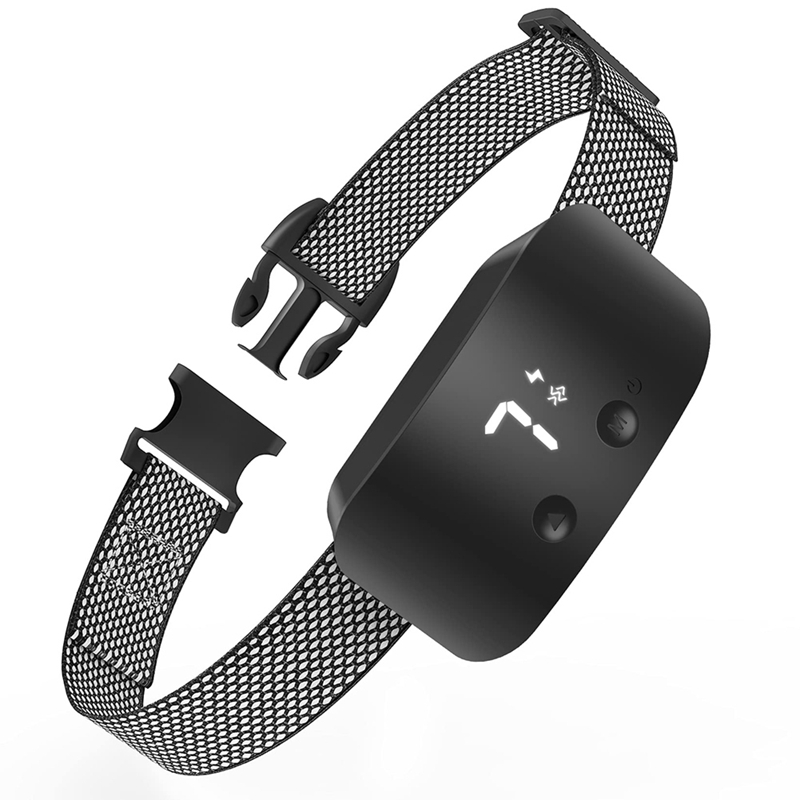
In some cases, other pets or small children might be frightened by the high-pitched bark collar and react negatively to it. If your dog lives with other animals, it is best to keep the bark collar on a leash outside of the other animal’s reach. If your dog lives with children, it is best to keep the bark collar off of them.
This way, you can give them a warning of what will happen if they continue to act aggressively. Stimulus-activated collars can be set up to deliver an unpleasant sound when your dog starts barking, so be sure to review the instructions on how to use them properly. Stimulus-activated collars are generally safe for use, as long as you follow the instructions carefully. This is the easiest method to stop your dog from barking, and it is safe for most dogs.
These are especially helpful in keeping your pup from barking excessively when he’s alone, as they will keep him from developing that barking as a habit. These types of collars will only deliver an electric shock of a set level, which makes them safer than the ones that can deliver a high voltage.
Some of these collars can even detect barking and use that information to deliver an electric shock. There are a variety of options when it comes to bark collars, and it can be overwhelming to know what to get. That’s why it’s best to just research different types of bark collars and see what the best one for your situation is.
Shock collars are meant to be used as a last resort when your dog displays problematic behaviors. Because they are meant to be used when your dog is doing something wrong. While these training systems can be a useful tool for training stubborn or aggressive behaviors, we recommend consulting with a professional behaviorist if you suspect that your dog may have any fears or phobias.
You can also read: Top Recommendation – Best Shock Collar for Boxer
At What Level Should I Set My Shock Collar?

Static shock collars often come with a dial or adjustment system that allows you to change the intensity of the shock. If you are using a static shock collar on a dog that isn’t highly reactive, you may want to start with a lower intensity level and slowly increase it until you reach the right level for your dog.
You should know that with a dog of any temperament you need to exercise the same. You’ll start from the lowest point and gradually move upwards until you reach an ideal level.
Each dog has their own unique personality. It’s important to always be mindful of your dog’s “body language” to determine if they are receptive to what you are trying to do. Be sure to pay attention to their facial expressions and body language to determine if they are comfortable with what you are doing. A dog may be less sensitive to a shocking level than another dog. You will work your way to find it for your dog.
Depending on your dog’s personality, you may want to try one type of shock collar over another. Some shock collars can be set to only deliver a small shock when the dog does something wrong. Others have multiple levels of intensity. Some models have a remote control so you can shock your dog from any distance. You can track how your dog responds to different sounds and patterns. Some dogs may be more likely to act aggressively if they hear another dog barking.
Keep in mind that the best dog shock collars are those that meet your dog’s needs. Be sure to consider the size, strength, and intensity of the stimulation your dog needs to feel comfortable, relaxed, and safe. Most importantly, be sure to follow the instructions that come with your dog shock collar.
There are some shock collars with excellent features you may have to pay a little more for them. While doing good research you may find a good piece at an affordable price.
You can also read: Expert Review – Best Shock Collar for Australian Shepherd
Advantages of Using A Shock Collar for Training

I’ll list some Pros for using a shock collar to train your dog:
- They will love the activities you’re doing together.
- As it’s so much faster than other training methods, it has the ability to be used for more situations, like when your dog comes across a new smell, encounters a new person, or even just goes on a walk by a new park and wants to sniff everything.
- You’ll not have to bear the unpleasant activities your dog does. Shock collar ill help you get rid of them.
- Your dog is always thinking about what you want him to do so he is excited to do it and shows that excitement by wagging his tail. This makes it easy to train your dog because he is always excited to please you.
- The stimulation from the shock collar will be so intense that they won’t be able to resist listening. This is especially helpful for dogs with attention issues.
- They are focused on you and what you are doing, so they don’t get distracted by other dogs or people.
- No need to get stressed out, you’re dog will be excited enough to work his way up.
- Dogs can learn to do almost anything that you can teach them. They can learn to walk on a leash, sit, shake, roll over, fetch, and even dance to a song if you have one.
- The best thing you can do for your dog is keep them active and engaged with the activities you will be doing with the help of the shock collar.
- These are the best training collars for stubborn dogs because they’re very effective in both correcting bad behavior and reinforcing good behavior. Once you’re done with the training with a shock collar, you’re dog will remain obedient to you even after.
- Yes, it is pretty harsh, but it works. No matter how far they stray, just use your remote to provide them a stimulus so, they can get back to you.
You might be interested in: Explore whether police dogs are trained with shock collars and the methods used in their training.
Disadvantages of Using A Shock Collar for Training

After the Cons, let’s mention some Cons to shock collar as wel.
- Unfortunately, this can cause a dog to associate the shock collar with something to be feared.
- This can make them very wary around other dogs, even their own kind. They may also become suspicious of people when they realize that everyone has the potential to use the shock collar on them
- If a shock is only used occasionally, then you don’t have to work as hard to control it and it can be done at a lower intensity. But in case of daily use you will have to increase the stimulus because every time you use it on them they will become less responsive to that stimulus level.
- Be sure to take note of the warning signs of shock collar abuse and never leave your dog unattended when they’re wearing one. They might not act it at first, but they could be struggling underneath the surface. If you notice any of these warning signs, get your dog off that collar right away.
- Victims of shock collar abuse might also show other behavioral changes. They might try to hide it, be nervous, be clingy, or do something else out of character. You’ll know if your dog has been shocked if they act like nothing happened.
- They’ve set up a higher standard for themselves and will be disappointed in their performance after using this device several times and seeing how easy it was for them to obey and please you.
- They will probably avoid any other physical gestures that might trigger painful memories. You’ll have to work hard to establish physical affection with your dog again, but it’s a necessary step to ensure he trusts you.
You can also read: Expert Recommendation – Best Shock Collar for American Bully
Can a Shock Collar Kill a Dog?

Training collars can be used to help train your dog. By applying a small electric shock to your dog when they do something that you do not want them to do, you can quickly reinforce the new behavior and prevent them from doing it again. Electric collars are also useful for helping your dog become familiar with their leash and collar.
Today, shock collars come with more than one mode of stimulation i.e. vibration and beep. The stimulation level of a shock collar is much lower than that of a static correction. When used correctly, it can be a useful training tool. There are several benefits to using a shock collar as opposed to a static correction. It’s very easy to use and can be set to different levels of stimulation.
If you’re trying to train your dog or teach your child a valuable lesson but it’s not happening the way you had hoped, a shock collar might just be the answer!
There are many positive uses for these dog training tools, and one of the main reasons people choose shock collars over other forms of training is that they are non-painful. The level of shock that comes with a shock collar is very low, and as long as you’re using it correctly, it can be a safe and effective way to discipline your dog or child.
High-voltage shocks improve control while low-intensity shock helps attract attention, collars available on the market have shock range from 0-75V to 330V.
So, if you are unsure about how to use one, it’s always best to consult a professional or veterinary professional to get advice on how to use one safely and properly.
You can also read: Proven Results – Best Shock Collar for Pitbull
FAQs
Can shock collars harm dogs?
Shock collars are generally considered to be relatively safe. If your dog wears a shock collar, you should make sure it is fitted correctly and that the settings are appropriate for your dog. However, there are some potential risks. As with anything that causes pain, if used incorrectly, they could cause lasting damage.
Some dogs may develop a negative association with the collar, associating it with being punished. This could lead to avoidance of behavior that elicits the collar, including jumping up or chewing. Some dogs may also experience stress and anxiety from the shock.
The best kind of training response to use is one that your dog will associate with positive reinforcement, such as a treat or a favorite toy. It should be something that your dog loves, not just something that he understands is connected with the desired behavior.
Can you use a shock collar to stop biting?
Just like with any training method, one size does not fit all when it comes to training your dog. If your dog is old or has a serious problem that requires a more hands-on approach, then you might want to seek professional help.
If you are looking to stop your dog from biting or chewing, then you may want to start with some positive reinforcement. Providing your dog with something enjoyable like praise, a favorite treat, or even a favorite toy can help to reinforce good behavior.
This type of training is not recommended for dogs who bite due to a lack of impulse control. Instead, you should look for ways to prevent your dog from biting in the first place.
What is a safe shock collar?
There’s always the risk of causing a severe injury, and even though a shock collar may only deliver a mild jolt, you can’t simply dismiss the risk of causing a serious injury to your dog. You can’t say a shock collar is totally safe.
However, there are a few things you can do to minimize the risk of an accident occurring with your dog. First, make sure that your dog is used to wearing the collar.
Practice putting it on your dog and letting them wear it around the house for a few days before you leave.
Second, make sure that the collar is adjusted properly. If your dog pulls a lot, you may want to go up a size on the collar to avoid any choking risk.
Third, make sure that the collar is fitted properly around your dog’s neck. If your dog seems uncomfortable with the collar, it may be time to try a different collar.
What is the difference between a shock collar and an electric fence?
Electric fences and collars work in different ways. Electric fences are usually placed along the boundary of your yard or property to keep fencing in a particular place. These fences can be either wired or wireless and can be placed on top of a fence or buried underground.
Electric collars, on the other hand, are meant for training your dog. Electric collars deliver a mild electric shock to your dog when he pulls on the leash. The shock is not meant to hurt your dog. It is to give him a warning that pulling can cause him to get a correction from you. Electric collars come in different types. Some are remote-controlled and can be activated with a remote control.
Electric fences come in a variety of shapes and sizes, and can be set at different heights. Most are set on posts, but some are mounted on the top of a fence or on a gate. The length of the fence and the type of electrical source can affect its effectiveness.
Do shock collars work on aggressive dogs?
Aggressive behavior isn’t something that can be triggered by a single incident, but rather is a long-term issue that needs to be managed. Despite this, there are ways to reduce aggression in your dog.
Aggressive behavior can often be linked back to fear and lack of confidence in their owners or surroundings. By using a shock collar on an aggressive dog, you’re providing a simple, easy way for them to feel safe again. As soon as you stop using the collar, the aggressive behavior may well return.
There’s no evidence that shocking an aggressive dog will help them to behave any better or that it’s safe or effective to do so. There’s also the risk of causing physical harm to your dog from shocks.
So, in this case I’ll recommend you to have a visit to the vet.
Can dog shock collars cause brain damage?
Research shows that these collars can cause hearing loss, tinnitus, and even seizures. If you have a fear or anxiety issue in your dog, this can be exacerbated even more by the shock of such a training collar. You can teach your dog to do a behavior with a lure or treat, or you can try to get him to do the behavior in a safe place, like your front yard.
If your dog does end up in a situation where his temperament or anxiety level is too high for him to perform the behavior in a safe place, then the training collar will have no effect and may even have the opposite effect.
How many amps is a shock collar?
When shopping for a shock collar, make sure to choose one that has a high-quality rechargeable battery with a long lifespan. It’s also important to choose a shock collar that has a low battery indicator. If the battery dies, then the shock collar won’t work.
Most commonly a shock collar is able to deliver 0.0003 amperes, so for a good output you should purchase a shock collar with high-quality batteries.
How long does it take to train a puppy not to bite?
Be sure to praise your dog when they do something good instead of taking their negative behavior personally. Do not leave your dog unsupervised with other animals or children to prevent them from biting.
Always keep your dog leashed when they are not in their own environment to prevent them from getting into things they are not supposed to. Keep your dog’s teeth clean by brushing them at least twice a week. The regular maintenance will ensure that your dog’s teeth are in good condition and will reduce the risk of your dog biting you.
A great way to avoid biting is to get your dog used to being handled from a young age. Handle them frequently when they are young to give them the positive association of being handled. Additionally, be sure to praise them when they do something good, like when they sit or come to you.
You can also try to avoid situations that may provoke your dog’s biting behavior, such as another dog approaching them. Avoid activities that might encourage your dog to bite.
With positive reinforcement you can achieve this goal, consistency, and patience is the key.
Can a shock collar hurt my dog’s throat?
Dogs can have a hypersensitive response to even the slightest stimulation, so using a shock collar on a dog who is sensitive can cause serious problems. You should always start with low levels of stimulation that your dog can handle and gradually increase the intensity over time to avoid causing any negative behavior.
If your dog reacts negatively to the shock collar, you should discontinue its use and consult a professional dog trainer.
In addition to the pain, using a shock collar can cause damage to your dog’s throat. The pressure from the shock and the vibrations can cause discomfort in the throat, and may make your dog start to whine. Redirecting your dog’s barking with a shock collar can cause stress in your dog, and may even make him more barky in the future.
Can a shock collar hurt my dog’s neck?
The best way to use a shock collar is to set the correct level of stimulation and make sure you have set the shock collar on your dog’s throat at the right place.
Never leave the shock collar on your dog when he is sleeping or eating as these are high-value activities that your dog needs to do regularly to stay in good mental and physical health. If your dog is showing any signs of anxiety, try treating the situation with a positive approach.
The collar should fit snugly enough to prevent slipping out of the collar, but not so tight that it cuts off your dog’s circulation. When choosing the right size for your dog, keep in mind that it will stretch a bit when your dog grows. Also, keep in mind that the collar cannot be so big that it leaves marks on your dog’s skin or so small that it isn’t strong enough to prevent injuries.
Final thoughts
Most Shock Collars have volts which are suitable for almost every dog but we should be careful about it. The level of stimulation you provide your dog is very important. Always start with the lowest intensity available on the collar and gradually work your way up.
However, not all dogs respond well to shock training. Furthermore, it’s important to note that these devices are not meant to be used regularly. They are simply another type of training tool that can be used alongside positive reinforcement.
Don’t use them with puppies, geriatric dogs, or dogs that are in poor health. They can put your dog at risk of injury if they aren’t used correctly.
As a general rule, you should avoid using shock training devices on dogs that aren’t obedience or hunting dogs. They can cause stress, which can make obedience training harder. And hunting dogs should only be exposed to these devices when they’re in the field.
And if you have anything else you would like to share about electric dog training, don’t be shy. After all, we are all here to learn and grow together!
Thanks for reading and be sure to stay tuned for more interesting articles. If you liked this article, don’t forget to share it on social media or with your family and friends!

